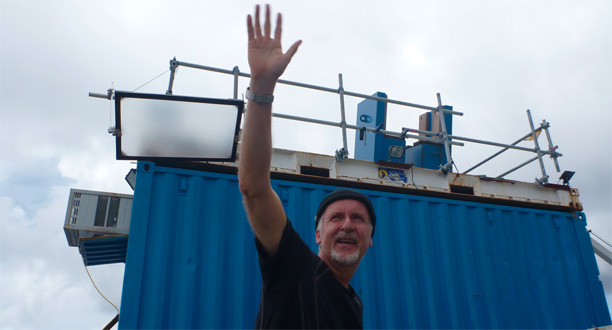We Just Did the Impossible

The Challenger Deep, Mariana Trench
“He’s on the bottom. His depth is 35,756 feet. All systems are performing well.” These were the words relayed to us on the Mermaid Sapphire after Jim’s historic, 7-mile (11-kilometer) touchdown on the sediments of the Challenger Deep.
We were in a small, dark communications room on the ship’s bridge. Five computer screens displayed data about the status and position of the DEEPSEA CHALLENGER. A hefty black console revealed the running time of the dive and vital information from the sub’s pilot sphere, including depth, speed, temperature, and oxygen and carbon dioxide levels. Life-support specialist John Garvin, communications experts Paul Roberts and Tim Bulman, and Jim’s wife, Suzy Amis Cameron, were listening intently to the words coming from the 32-foot inflatable boat a mile (1.6 kilometers) in front of our ship. The engines and generators of the Mermaid Sapphire overpower acoustic signals from the sub; the much quieter communication boat picked up the signals and relayed them to us.
Crouched inside the pilot sphere of the DEEPSEA CHALLENGER, Jim left the surface at 5:15 a.m. Ten minutes later, he and his gravity rocket were at 4,000 feet (1,219 meters) and moving toward the center of the Earth at a speed of 4.1 knots. Forty-five minutes later he passed through 14,800 feet (4,511 meters). At 32,000 feet (9,754 meters) he slowed his speed to two knots. One hundred and fifty-six minutes after leaving the starlit surface, he was on the bottom.
During the entire descent, everyone in the communications room toggled between concern and confidence. We knew that the forces of the ocean—the wind, waves, currents, cold, darkness, and pressure—had been doing their majestic thing for billions of years. We knew that at the bottom of the Challenger Deep the pressure on the pilot sphere would be equivalent to the weight of more than 20 space shuttles. But we had confidence in the DEEPSEA CHALLENGER and how she’d been assembled and tested.
Three days ago, on the island of Ulithi, Jim spoke with Ali Haleyalut, a master navigator from the island of Yap. Afterward he said, “For millennium, explorers have been pitting themselves against the ocean. Here in Micronesia, they built outrigger canoes, sailed them thousands of miles from island to island, and revealed great truths about the known world. They were successful because they trusted their knowledge, their technology, and their teams. We are part of that continuum.
“This is a normal dive for our new vehicle. She was designed and built to withstand the forces at full ocean depth. She’s made piloted dives to 1,000, 4,000, and 8,000 meters and an unpiloted descent to more than 10,000 meters. We’re trying to reveal great truths about the deepest, darkest chasm on Earth. We’ll be successful because we trust our knowledge, our technology, and ultimately our team.”
Jim spent 2 hours and 34 minutes on the bottom. He drove across a flat, tan-colored seafloor and climbed 45 meters up a slope. The sub’s hydraulic system malfunctioned, and he was unable to recover rock samples, but he picked up a sediment sample, and his five cameras brought back a treasure-trove of 3-D visual information.
After his 90-minute ascent to the sunlight, Jim asked us to assemble in the ship’s mess hall. He came in and looked at the men who built his sub, moved it into and out of the ocean, and filmed every step of the journey. Ron Allum had been working on this project for almost a decade. Others had been working on it for more than a year. Some had been away from their families for months. A few were so tired their eyes were bloodshot and they were speaking in grunts.
“We just did the impossible,”Jim told us. “You remember when you were a kid and you wanted to build a rocket ship in your garage and fly it to the moon? That’s exactly what we just did. And you guys made it happen.
“To me it’s such a great celebration of how a small team can do such extraordinary things. Not Northrup-Grumman, McDonald-Douglas, or NASA, but a small team where everybody has many skills and come together like family.”
“How was it on the bottom?” someone asked. Jim paused and said, “I never felt more removed from humanity. I felt outside of any kind of time and space. The challenge of getting down there—to lay eyes on it and begin to understand it—makes it a very special place.
“We set a goal for ourselves—to challenge the unknown, to go and look it in the eye, and we did it. And when I say we, I mean it. I didn’t build that sub. I didn’t launch it. You guys made it happen.”
Photograph by Dr. Joe MacInnis
Editor’s Note: Recalculation of the maximum depth of the Challenger Deep dive showed the sub actually reached 35,787 feet (6.77 miles/10.90 km).



